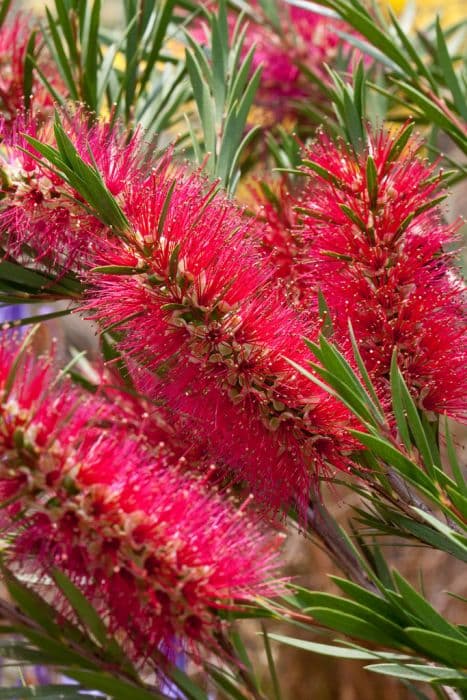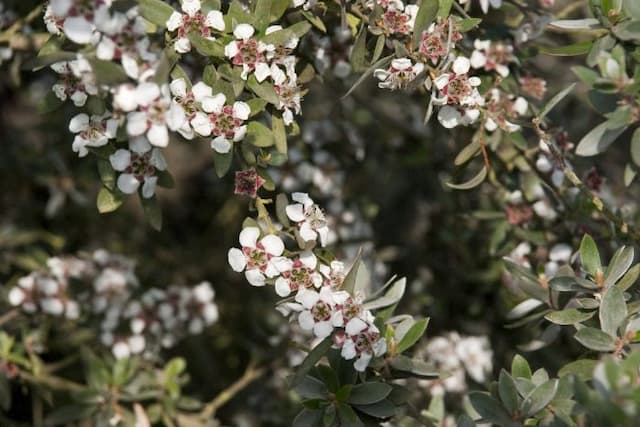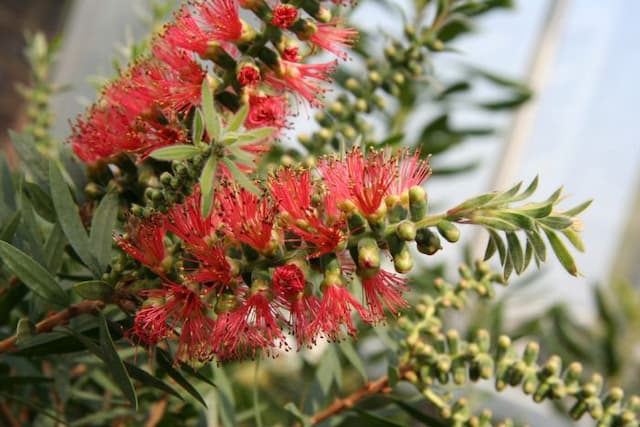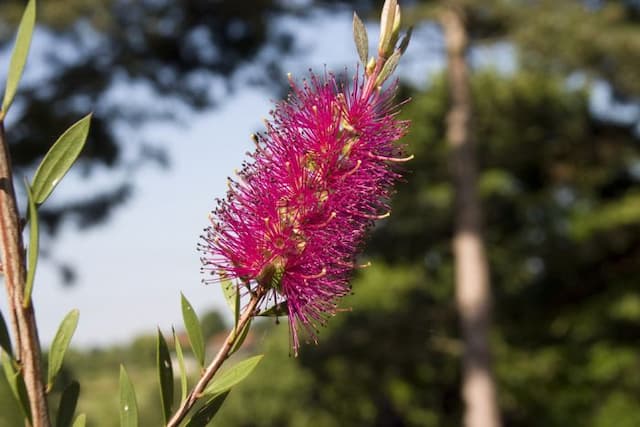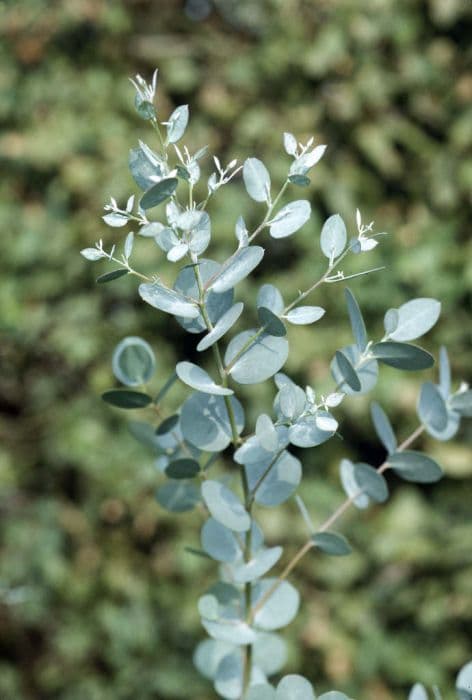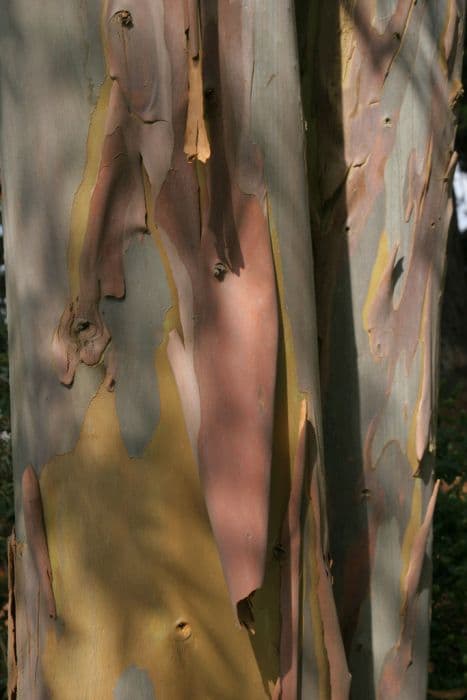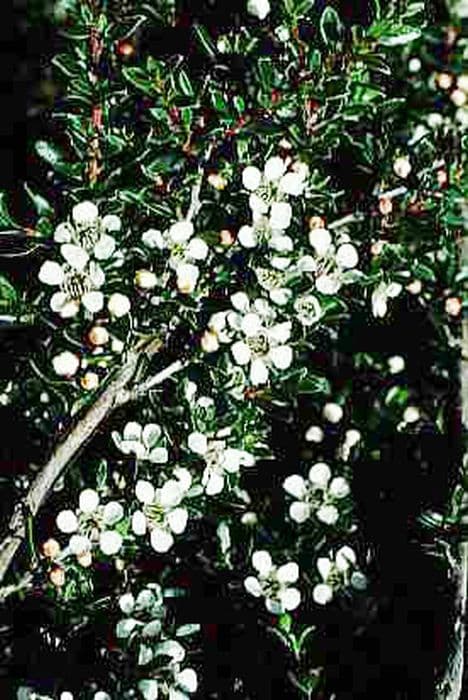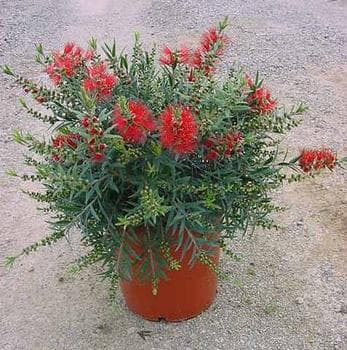Tingiringi Gum Eucalyptus glaucescens

ABOUT
Eucalyptus glaucescens, commonly known as Tingiringi gum, is a plant recognized for its distinct features. The tree's bark peels away in strips to reveal a smooth surface that can vary in color from patchy whites to grays and sometimes greens or browns. Its leaves are a standout feature, typically with a bluish or glaucous, waxy coating, giving them a frosty appearance, hence its species name glaucescens which refers to this bluish-gray coloration. The leaves are arranged alternately on the branches, creating a dense canopy. As the plant matures, the shape of the leaves can change from a more circular, heart-shaped form to a longer, more lance-shaped silhouette. The Tingiringi gum produces flowers that are clustered in groups. Each individual flower is relatively small and may not seem significant on its own, but the clusters create a visual impact. These whitish or cream-colored blooms attract a variety of pollinators. Following the flowering season, the plant develops woody, cone-shaped seed capsules that release seeds when mature. Overall, the appearance of the Tingiringi gum is a combination of these handsome bark features, the striking blue-green foliage, the decorative flowers, and the distinctive seed capsules, creating a visual display that is appealing both in a natural setting and in cultivated landscapes.
About this plant
 Names
NamesFamily
Myrtaceae
Synonyms
Tingiringi Gum, Blue Mountain Ash, Glaucescent Eucalypt
Common names
Eucalyptus glaucescens
 Toxicity
ToxicityTo humans
The Eucalyptus plant, including Eucalyptus glaucescens, commonly known as the Tingiringi Gum, contains compounds that can be toxic to humans if ingested. The essential oils in the plant, especially in the leaves, contain eucalyptol, which can be harmful when consumed in large quantities. Symptoms of eucalyptus poisoning in humans may include nausea, vomiting, diarrhea, abdominal pain, and central nervous system depression, which can lead to drowsiness, muscle weakness, and, in severe cases, respiratory problems. It is generally advisable not to ingest any part of the Eucalyptus plant due to its potential toxicity.
To pets
The Eucalyptus plant, known as the Tingiringi Gum in the case of Eucalyptus glaucescens, is toxic to pets if ingested. The plant contains essential oils, particularly eucalyptol, which can cause symptoms such as vomiting, diarrhea, salivation, weakness, depression, and, in severe cases, seizures or comas in pets. Ingestion of the leaves or stems can lead to these symptoms, and it is important to keep pets away from Eucalyptus plants. If you suspect your pet has ingested part of the plant, it is crucial to seek veterinary care immediately.
 Characteristics
CharacteristicsLife cycle
Perennials
Foliage type
Evergreen
Color of leaves
Blue-green
Flower color
White
Height
60 feet (18 meters)
Spread
25 feet (7.6 meters)
Plant type
Tree
Hardiness zones
7
Native area
Australia
Benefits
 General Benefits
General Benefits- Ornamental Value: Eucalyptus glaucescens, commonly known as Tingiringi gum, offers aesthetic appeal with its striking blue-grey leaves and attractive bark.
- Habitat for Wildlife: It provides a habitat and food source for various bird species, insects, and other wildlife.
- Shade and Shelter: The tree’s size and foliage offer considerable shade and shelter from elements such as wind and sun.
- Drought Resistance: Its ability to endure periods of low water availability makes it suitable for xeriscaping and dry climates.
- Soil Erosion Control: The extensive root system helps stabilize the soil and prevent erosion.
- Windbreaks: Its height and density serve well as windbreaks to protect crops, soil, and structures from strong winds.
- Timber Production: Eucalyptus glaucescens produces quality wood for construction, furniture, and paper products.
- Essential Oils: While excluding medical benefits, the leaves can be used to extract essential oils for use in aromatherapy and cosmetics.
- Reforestation: Because of its rapid growth rate, it’s used in reforestation projects and to reclaim disturbed sites.
- Honey Production: The flowers of Tingiringi gum are a good nectar source for honey bees, leading to the production of uniquely flavored honey.
 Medical Properties
Medical Properties- Antimicrobial: Eucalyptus glaucescens essential oils are known to possess antimicrobial properties against a range of bacterial and fungal pathogens.
- Anti-inflammatory: The plant may exhibit anti-inflammatory effects, helping to reduce inflammation and associated pain in certain conditions.
- Expectorant: Eucalyptus is commonly used to help relieve congestion and coughs, aiding in the removal of mucus from the respiratory tract.
- Antioxidant: Eucalyptus leaves contain flavonoids and tannins that may have antioxidant properties, which help in protecting the body from oxidative stress.
- Analgesic: The essential oil extracted from Eucalyptus glaucescens might act as a pain reliever for certain types of pain.
- Antispasmodic: Components in Eucalyptus may help to relieve muscle spasms.
 Air-purifying Qualities
Air-purifying QualitiesThis plant is not specifically known for air purifying qualities.
 Other Uses
Other Uses- Eucalyptus glaucescens, commonly known as Tingiringi gum, can be used as a natural insect repellent due to its aromatic leaves that many pests find unpleasant.
- The wood of Tingiringi gum is durable and resistant to rot, making it suitable for outdoor construction, such as fencing and garden features.
- The foliage can be used in floral arrangements, both fresh and dried, providing a unique, silvery-blue touch to bouquets and wreaths.
- Essential oils extracted from Tingiringi gum can be used in perfumery and aromatherapy for their distinctive eucalyptus scent.
- Due to its fast growth and high biomass production, Tingiringi gum can be used in reforestation projects and to combat soil erosion.
- The tree serves as a valuable source of nectar and pollen for bees and other pollinating insects, thereby supporting local ecosystems.
- The bark of the Tingiringi gum can be used as a natural dye in textile production, offering a range of tan and reddish colors.
- Wood chips from the Tingiringi gum are useful in barbecue and smoking processes to impart a unique flavor to meats and other foods.
- Tingiringi gum can be planted as a windbreak tree to protect smaller, more fragile plants from strong winds and storms.
- Eucalyptus glaucescens leaves can be used in crafts and paper-making, contributing texture and a fresh eucalyptus scent to handmade papers.
Interesting Facts
 Feng Shui
Feng ShuiThe Eucalyptus is not used in Feng Shui practice.
 Zodiac Sign Compitability
Zodiac Sign CompitabilityThe Eucalyptus is not used in astrology practice.
 Plant Symbolism
Plant Symbolism- Healing: Eucalyptus is often associated with healing due to its medicinal properties. Its oil is used to relieve coughs, colds, and congestion.
- Protection: The plant is believed to protect against sickness and is often used in cleansing rituals to ward off negative energies.
- Renewal: As eucalyptus trees shed their bark and reveal new, smooth skin underneath, they symbolize personal renewal and the shedding of old habits.
- Purity: The clean scent of eucalyptus is associated with purity and cleanliness, signaling a fresh start or a clean slate.
 Water
WaterThe Eucalyptus glaucescens, commonly known as Tingiringi gum, should be watered deeply but infrequently to mirror its natural dry habitat conditions. Aim to water the plant once every week or two, allowing the soil to dry out between watering sessions. During the active growth season, usually in spring and summer, they may require more frequent watering, about once a week. Use approximately 1 to 2 gallons of water for each watering session to ensure deep soil saturation. During dormancy in the fall and winter, reduce watering to once every two to three weeks.
 Light
LightTingiringi gum thrives in full sun exposures, requiring at least six hours of direct sunlight each day. This eucalyptus should be planted or placed in a spot where it can receive unfiltered sunlight for most of the day. Avoid shaded areas as insufficient light can lead to poor growth and a lack of the desired foliage coloration.
 Temperature
TemperatureTingiringi gum prefers moderate to warm temperatures, with an ideal range between 60°F and 80°F. The plant can survive minimum temperatures down to about 50°F, but frost or prolonged exposure to temperatures below this can be damaging. It is not cold hardy, so in regions where temperatures drop below freezing, it should be grown in containers that can be moved indoors or provided with frost protection.
 Pruning
PruningPruning Tingiringi gum is important to maintain its shape and promote healthy growth. Prune in late winter or early spring before the new growth begins. Remove any damaged or diseased branches, any that are crossing or rubbing against each other, and trim back to maintain the desired size and shape. Pruning once a year is typically sufficient unless shaping is required for a specific landscape purpose.
 Cleaning
CleaningAs needed
 Soil
SoilTingiringi gum prefers well-drained, fertile soil with a pH ranging from 5.5 to 6.5. A mix of loam, sand, and compost works well, enhancing drainage and fertility.
 Repotting
RepottingTingiringi gum typically requires repotting every 2 to 3 years to accommodate its growth and to refresh the soil.
 Humidity & Misting
Humidity & MistingTingiringi gum thrives in an environment with moderate humidity levels but is quite adaptable to various conditions.
 Suitable locations
Suitable locationsIndoor
Provide bright light, avoid wet feet, and ensure good air circulation.
Outdoor
Full sun, shield from strong winds, and space well for air flow.
Hardiness zone
7-10 USDA
 Life cycle
Life cycleEucalyptus glaucescens, commonly known as the Tingiringi gum, begins its life as a seed, typically dispersed by the wind or through animal vectors. Once the seed lands in a suitable location with moist soil and sufficient sunlight, it germinates and a small seedling emerges. The seedling undergoes rapid growth, transitioning into the juvenile phase, which is characterized by the presence of round, bluish-green juvenile leaves. As the plant matures, it enters the adult phase, identifiable by the appearance of elongated, sickle-shaped adult leaves, and begins to develop a thick, fibrous bark. The Tingiringi gum reaches its reproductive maturity by producing clusters of white flowers that attract pollinators, leading to the formation of woody capsules that contain numerous seeds. After pollination and seed dispersal, the plant may undergo multiple flowerings throughout its life cycle, which can span several decades, given the right environmental conditions.
 Propogation
PropogationPropogation time
Spring to Summer
Propogation: The most popular method of propagating Eucalyptus glaucescens, commonly known as Tingiringi gum, is through seed sowing. The best time for sowing seeds is generally in the spring after the danger of frost has passed. For successful propagation, seeds are typically surface sown onto a well-draining seed raising mix and lightly covered with a fine layer of soil or vermiculite to keep them in place. The soil needs to be kept moist but not waterlogged. Providing adequate warmth, about 68°F (20°C), and bright light will assist in the germination process, which can take place within a few weeks. It is crucial to avoid deep planting as eucalyptus seeds require light to germinate successfully. After germination, seedlings should be carefully thinned and can later be transplanted outdoors once they have developed a robust root system and are large enough to handle.
